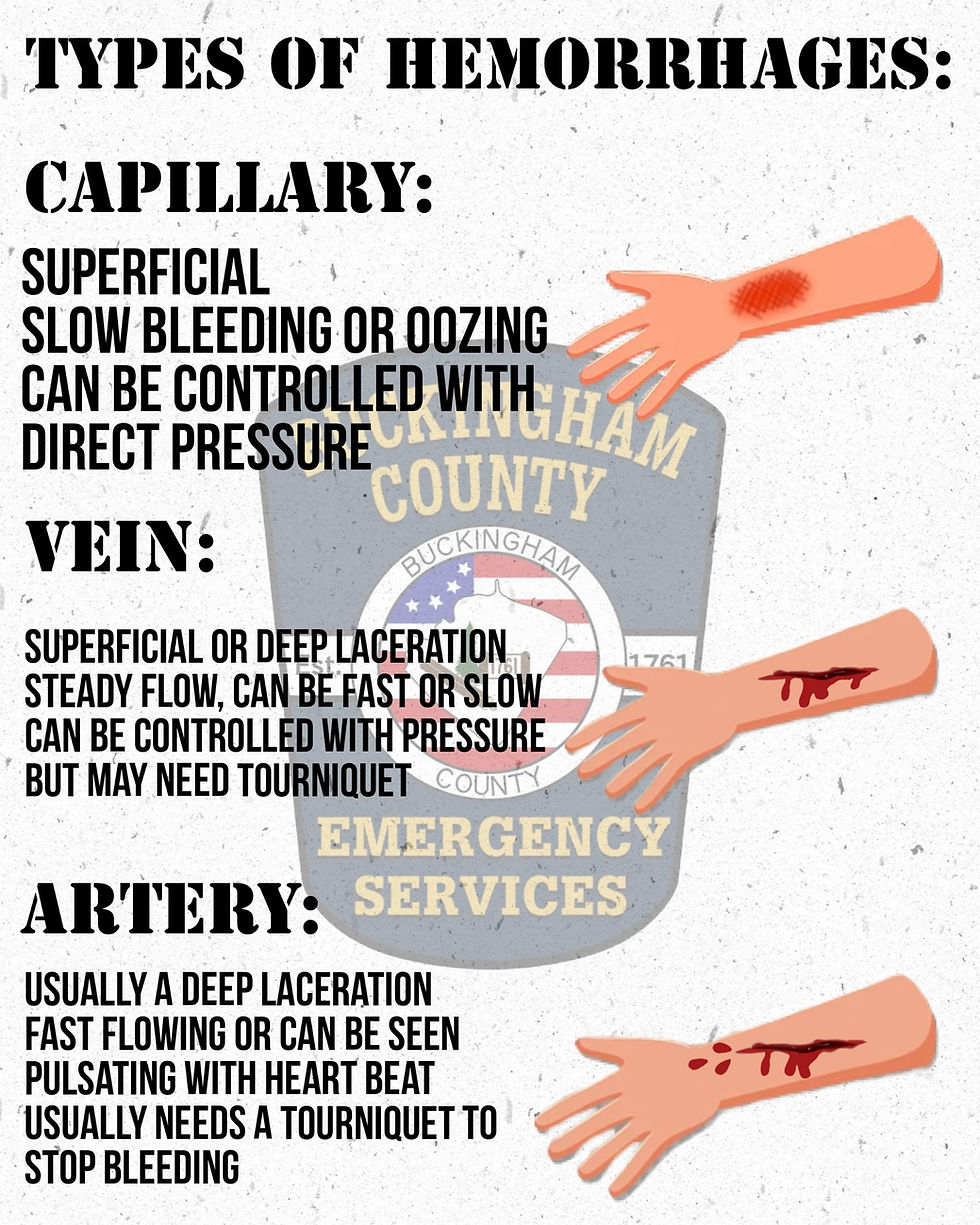Bleeding Control
- afinch85
- Jul 23
- 3 min read

Bleeding injuries can range from a minor paper cut to a deep laceration or amputation. Initial treatment for most bleeding starts the same. Find the source of the bleeding and apply direct and constant pressure to the wound. Applying direct pressure to the wound allows time for the bodies natural clotting process to occur, allowing the bleeding to stop.
The amount of blood lost, and how quickly, depends on the type of vessel that is injured. There are three sources of bleeding in the body:
1. Capillary: Associated with superficial wounds such as papercuts or road rash. Capillary bleeding is generally slow and oozing in nature. While not usually an emergency, bleeding that can not be controlled with direct pressure should be evaluated.
2. Venous: These wounds can be superficial or deep depending on how close to the surface of the skin the vein is. Venous bleeding has a steady flow and can be fast or slow. While most of these injuries can be controlled with direct pressure, some may require tourniquet placement.
3. Arterial: These wounds are usually very deep or associated with amputations of extremities. Arterial bleeding is usually fast and steady and can appear to be pulsating with the patient's heartbeat. These injuries almost always need tourniquet placement to control bleeding due to the high pressure within arteries. Arterial injuries are always an emergency and calling 911 should not be delayed.

Tourniquets are ONLY needed when bleeding can not be controlled with direct pressure. Tourniquets can only be placed on extremities. Tourniquets should be placed as close to the armpit or groin as possible. If the injury is higher up on the extremity, do not place a tourniquet unless you have 2-3 inches above the wound. Tourniquet should be tightened until bleeding completely stops. Placement of a tourniquet can be very painful for the patient and the tourniquet should not be removed due to pain. If no commercially made tourniquet is available, do NOT use something in its place such as a belt or articles of clothing. Apply hard constant pressure until one becomes available or EMS arrives on scene. Please refer to the below image and video link for a more in depth explanation on tourniquet placement. Tourniquets are commercially available for anyone who wishes to have one. Below is a link to TCCC approved tourniquets. Unapproved tourniquets should be avoided due to higher chance of failure when using.
Recommended tourniquets: https://books.allogy.com/.../f94aad5b-78f3-42be-b3de.../
Tourniquet placement: https://deployedmedicine.com/content/859

Special Considerations:
Nose bleeds: Patient should sit forward and pinch the nostrils together. The clot formed may irritate the nose or feel strange, but do not try to dislodge the clot as this will allow bleeding to resume.
Impalements: Do NOT remove the object from the patient. The object is most likely keeping pressure on internal vessels and removing it can cause fatal bleeding. Only remove the object if it is blocking the patients airway or if CPR needs to be preformed and the object is impeding chest compressions.
Amputations: Some amputation mechanisms can cause the vessels to close off and prevent further bleeding. If severe bleeding is present, place a tourniquet. Amputated part should be kept in a cool place. Do not place directly on ice. Do not delay blood control to find any missing body parts.
Patients on blood thinners (anticoagulants) will take substantially longer to stop bleeding due to the therapeutic effects of the medication.
Disclaimer: The above information and associated graphics are not meant to be taken as advice over that given by a medical professional. If you feel that yourself or someone else is experiencing a medical emergency, do not hesitate to dial 911.
Other sources:


Comments